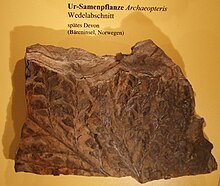Progymnosperm
| Progymnosperm Temporal range:
| |
|---|---|

| |
| Archaeopteris fossil leaves | |
| Scientific classification | |
| Kingdom: | Plantae |
| Clade: | Tracheophytes |
| Class: | †Progymnospermopsida |
| Orders | |
The progymnosperms are an extinct group of woody, spore-bearing plants that is presumed to have evolved from the trimerophytes, and eventually gave rise to the gymnosperms, ancestral to acrogymnosperms and angiosperms (flowering plants).[1] They have been treated formally at the rank of division Progymnospermophyta or class Progymnospermopsida (as opposite). The stratigraphically oldest known examples belong to the Middle Devonian order the , with forms such as , in which the vegetative organs consisted of relatively loose clusters of axes.[2] Tetraxylopteris is another example of a genus lacking leaves. In more advanced aneurophytaleans such as Aneurophyton these vegetative organs started to look rather more like fronds,[3] and eventually during Late Devonian times the aneurophytaleans are presumed to have given rise to the pteridosperm order, the Lyginopteridales. In Late Devonian times, another group of progymnosperms gave rise to the first really large trees known as Archaeopteris. The latest surviving group of progymnosperms is the Noeggerathiales, which persisted until the end of the Permian.[4]
Other characteristics:
- Vascular cambium with unlimited growth potential is present as well as xylem and phloem.
- Ancestors of the earliest seed plants as well as the first true trees.
- Strong monopodial growth is exhibited.
- Some were heterosporous but others were homosporous.
Phylogeny[]
Progymnosperms are a paraphyletic grade of plants.[5][6][7]
|
Progymnosperms |
References[]
- ^ Stewart WN, Rothwell GW (1993). Paleobiology and the evolution of plants. Cambridge University Press. p. 521pp.
- ^ Lang WH (1926). "II.—Contributions to the Study of the Old Red Sandstone Flora of Scotland. I. On Plant-Remains from the Fish-Beds of Cromarty. II. On a Sporangium-bearing Branch-System from the Stromness Beds". Earth and Environmental Science Transactions of the Royal Society of Edinburgh. 54 (2): 253–79. doi:10.1017/S0080456800027599.
- ^ Serlin BS, Banks HP (1979). "Morphology and anatomy of Aneurophyton, a progymnosperm from the Late Devonian of New York". Palaeontographica Americana. 8: 343–359.
- ^ Wang J, Hilton J, Pfefferkorn HW, Wang S, Zhang Y, Bek J, et al. (March 2021). "Ancient noeggerathialean reveals the seed plant sister group diversified alongside the primary seed plant radiation". Proceedings of the National Academy of Sciences of the United States of America. 118 (11): e2013442118. doi:10.1073/pnas.2013442118. PMC 7980368. PMID 33836571.
- ^ Crane PR, Herendeen P, Friis EM (October 2004). "Fossils and plant phylogeny". American Journal of Botany. 91 (10): 1683–99. doi:10.3732/ajb.91.10.1683. PMID 21652317.
- ^ Pelletier (2012). Empire biota: taxonomy and evolution 2nd ed. Lulu.com. p. 354. ISBN 978-1329874008.
- ^ Wang J, Hilton J, Pfefferkorn HW, Wang S, Zhang Y, Bek J, et al. (March 2021). "Ancient noeggerathialean reveals the seed plant sister group diversified alongside the primary seed plant radiation". Proceedings of the National Academy of Sciences of the United States of America. 118 (11): e2013442118. doi:10.1073/pnas.2013442118. PMC 7980368. PMID 33836571.
External links[]
- Middle Devonian first appearances
- Middle Devonian plants
- Mississippian plants
- Mississippian extinctions
- Late Devonian plants
- Paraphyletic groups
- Plant stubs
- Paleobotany stubs